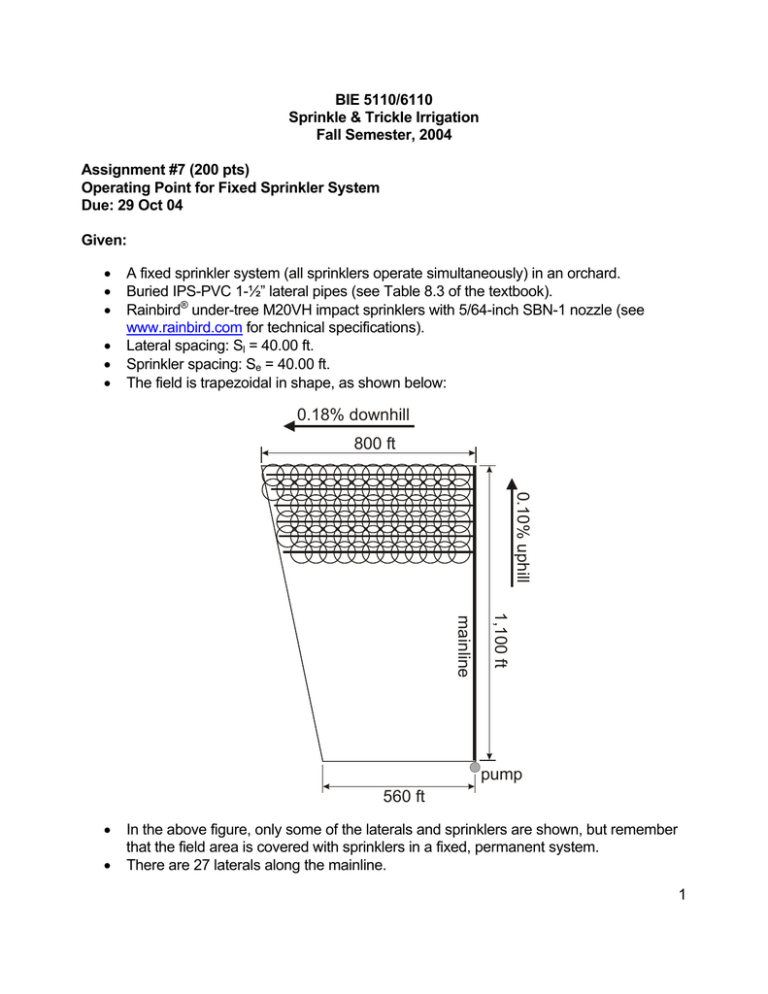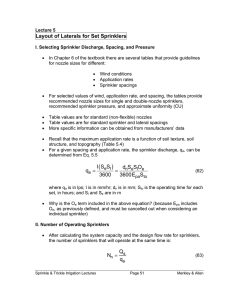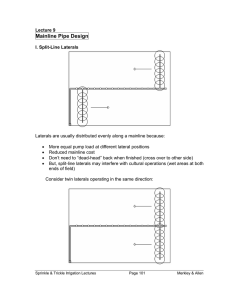BIE 5110/6110 Sprinkle & Trickle Irrigation Fall Semester, 2004 Assignment #7 (200 pts)
advertisement

BIE 5110/6110 Sprinkle & Trickle Irrigation Fall Semester, 2004 Assignment #7 (200 pts) Operating Point for Fixed Sprinkler System Due: 29 Oct 04 Given: • • • • • • A fixed sprinkler system (all sprinklers operate simultaneously) in an orchard. Buried IPS-PVC 1-½” lateral pipes (see Table 8.3 of the textbook). Rainbird® under-tree M20VH impact sprinklers with 5/64-inch SBN-1 nozzle (see www.rainbird.com for technical specifications). Lateral spacing: Sl = 40.00 ft. Sprinkler spacing: Se = 40.00 ft. The field is trapezoidal in shape, as shown below: 0.18% downhill 800 ft 0.10% uphill 1,100 ft mainline pump 560 ft • • In the above figure, only some of the laterals and sprinklers are shown, but remember that the field area is covered with sprinklers in a fixed, permanent system. There are 27 laterals along the mainline. 1 • • • • • • Note the field slopes along mainline and lateral directions. The suction (upstream) side of the pump has a 4-ft static lift from a pond and 10 ft of 8” PVC pipe (ID = 8.205”) with one 90-degree elbow and a strainer screen at the inlet. The mainline is 8” PVC pipe (ID = 8.205”), and is 1,100-ft long. Sprinkler riser height is: hr = 3.0 ft. A Berkeley model 4GQH pump curve as shown on the following page. You will use the characteristic curve for 1600 RPM. Ignore minor losses along the mainline and laterals. Required: 1. Determine the irrigated area (acres). 2. Develop an equation for sprinkler flow rate (q) as a function of pressure (P), whereby q = KdPx (you determine Kd and x based on manufacturer’s data). Note that for a straight-bore nozzle, you would expect x to be very close to 0.5, as in Eq. 5.1a. 3. Determine the number of sprinklers along each lateral, where lateral #1 is the closest to the pump, and lateral #27 is the furthest from the pump. 4. Develop at least five points on the system curve and present those points numerically in a table. You should write a macro (Excel) or computer program to do this (don’t attempt to do it by hand with only a calculator). 5. Plot the system curve points on the attached pump curve graph, and draw a smooth curve through the points. 6. Determine the operating point (Q in gpm & TDH in ft) for this system. 7. Determine the average application rate for the whole field area. Do you work in an organized, neat way. Make comments about assumptions and other technical issues as appropriate. Turn in all your work, including the code for your macro or computer program. 2 Solution: 1. The irrigated area is approximately: A= 0.5(800 + 560)(1100) = 17.2 acres 43,560 Due to the trapezoidal field shape, and the fact that there are 27 laterals at Sl = 40 ft, the effective irrigated area is slightly less than 17.2 acres. 2. A linear regression is performed on logarithms of the manufacturer’s data for P and q (Rainbird® M20VH with 5/64-inch SBN-1 nozzle): Pressure (psi) 25 30 35 40 45 50 Flow (gpm) 0.88 0.97 1.05 1.12 1.19 1.25 ln(P) 3.2189 3.4012 3.5553 3.6889 3.8067 3.9120 ln(q) -0.1278 -0.0305 0.0488 0.1133 0.1740 0.2231 given an R2 of 0.9996, and the following equation: q = 0.173P0.506 for q in gpm; and P in psi. Note that the exponent is close to 0.500, which is expected for a straight-bore nozzle. But notice also that allowing for the flexibility in the exponent, x, gives a better mathematical fit to the manufacturer’s data. 3. Let the first lateral be located at ½Sl from the lower edge of the field (where the pump is located). Calculate the number of sprinklers per lateral by rounding the potential lateral length by Se. The potential lateral length is calculated by linear interpolation along the left side of the field area (see the figure given above). The equation is given below, and the calculation results are shown in the following table. ⎛ 800 − 560 ⎞ L = 800 − (1,100 − y) ⎜ ⎟ ⎝ 1,100 ⎠ where y is the distance along the mainline (ft); and L is the potential lateral length (ft). 3 Lateral 1 2 3 4 5 6 7 8 9 10 11 12 13 14 15 16 17 18 19 20 21 22 23 24 25 26 27 Distance (ft) 20 60 100 140 180 220 260 300 340 380 420 460 500 540 580 620 660 700 740 780 820 860 900 940 980 1,020 1,060 Length No. of (ft) Sprinklers 564.4 14 573.1 14 581.8 15 590.5 15 599.3 15 608.0 15 616.7 15 625.5 16 634.2 16 642.9 16 651.6 16 660.4 17 669.1 17 677.8 17 686.5 17 695.3 17 704.0 18 712.7 18 721.5 18 730.2 18 738.9 18 747.6 19 756.4 19 765.1 19 773.8 19 782.5 20 791.3 20 4. Develop a computer program to start with a given pressure at the furthest downstream sprinkler on lateral #27, calculate the flow rate at that sprinkler, calculate the pressure at the next upstream sprinkler, then the flow rate at that sprinkler, and so on, until reaching the mainline. Calculate the pressure in the mainline at the location of lateral #26, then iterate along lateral #26 to get the same pressure in the mainline at that location. Repeat for all other laterals, moving in the upstream direction, until a pressure is obtained for the upstream end of the mainline. The system flow rate is known from these calculations (sum of all individual sprinklers). Assume pipe leakage is zero. Knowing the system flow rate, determine the losses in the suction side of the pipe, and determine TDH by adding the velocity head at the beginning of the mainline, the pressure head at the beginning of the mainline, the static lift on the suction side, and the hydraulic losses on the suction side of the pump. 4 Preliminary calculations and assumptions: Assume a water temperature of 10°C, giving a kinematic viscosity of: 1.306(10)-6 m2/s, or 1.406(10)-5 ft2/s. Use the Swamee-Jain equation with ε = 1.5(10)-6 m, or 4.92(10)-6 ft for PVC to obtain the Darcy-Weisbach friction factor, f. From Table 8.3, the ID of the lateral pipe is 1.754 inches (0.1462 ft). The ID of the mainline pipe is 8.205 inches (0.6838 ft). Once the pressure at the upstream end of the mainline is calculated, the additional TDH values include static lift, velocity head, and losses in the suction side of the pump, plus the riser height. Assume the pump outlet is at the same elevation as the upstream end of the mainline (you don’t know if the mainline or laterals are buried, nor how deep they might be, but this information could be used to develop a somewhat more specific design). V2 TDH = 2.308Pmain + hlift + hr + (hf )suction + 2g where TDH is in ft; Pmain is the pressure at the upstream end of the mainline (psi); hlift is given as 4.0 ft; hr is given as 3.0 ft; (hf)suction are the hydraulic losses in the suction pipe (ft); and the last term is the velocity head (ft). The iterative part is to determine Pmain; the rest of the TDH terms are easy to calculate directly. From Table 11.2 (minor loss coefficients): 8-inch “basket strainer”: Kr = 0.75 8-inch “regular 90-deg elbow”: Kr = 0.26 Velocity head in suction pipe: V2 8Q2 = 2 4 = 0.1151Q2 2g gπ D Friction loss in suction pipe: L V2 hf = f = 1.684 f Q2 D 2g 5 Putting it all together: TDH = 2.308Pmain + 4.0 + 3.0 + 1.684 f Q2 + 0.1151Q2 (1 + 0.75 + 0.26 ) or, TDH = 2.308Pmain + 7.0 + Q2 [1.684 f + 0.2314] The results are given in the table below: Qs P (psi) (gpm) 20 367.2 25 411.2 30 451.0 35 487.6 40 521.6 45 553.6 50 583.9 55 612.7 60 640.2 Pmain (psi) Re f TDH (ft) 21.8 27.2 32.7 38.1 43.5 48.9 54.3 59.7 65.1 108,347 121,318 133,061 143,853 153,902 163,344 172,277 180,777 188,901 0.01761 0.01721 0.01689 0.01663 0.01641 0.01622 0.01605 0.01590 0.01577 57.50 70.09 82.66 95.21 107.74 120.26 132.77 145.28 157.77 where P is the pressure at the furthest downstream sprinkler on lateral #27; Qs is the total system flow rate; Pmain is the pressure at the upstream end of the mainline (just downstream of the pump); Re is the Reynold’s number in the suction pipe; f is the value from Swamee-Jain; and TDH is the total dynamic head. 5. The system curve (Qs versus TDH) is superimposed upon the pump manufacturer’s curves, as shown in the figure below. 6. The operating point (intersection of the system curve and the 1600 RPM pump curve) is seen to be approximately: Qs = 568 gpm TDH = 126 ft 7. The average application rate at this operating point is approximately: AR avg = (568)(12)(3600) = 0.075 inch/hr (458)(40)(40)(448.86) or 1.9 mm/hr. 6 300 275 250 225 TDH (ft) 200 175 150 125 100 75 50 25 0 200 400 600 800 1000 1200 1400 1600 Flow rate (gpm) The MS Excel VBA listing follows: Const Const Const Const Const Const Const Const Pi = 3.141593 Se = 40# Sl = 40# LatCount = 27 Dlat = 0.1462 Dmain = 0.6838 SoLat = -0.0018 SoMain = 0.001 'ft 'ft 'number of laterals 'ft 'ft 'ft/ft 'ft/ft Function hf(ByVal Q As Double, ByVal D As Double, ByVal L As Double) As Double '-----------------------------------------------------------------------------' Returns friction loss in feet of water head (Darcy-Weisbach). ' If turbulent, uses the Swamee-Jain equation for the friction factor, f. '-----------------------------------------------------------------------------Dim Re As Double, RelRough As Double, f As Double viscosity = 0.00001406 'ft2/s RelRough = 0.00000492 / D Re = 4 * Q / (viscosity * Pi * D) If Re > 4000 Then f = RelRough / 3.75 + 5.74 / Re ^ 0.9 f = WorksheetFunction.Log10(f) f = 0.25 / f ^ 2 Else f = 64 / Re End If 'Turbulent 'Laminar 7 hf = 8# * f * L * (Q / Pi) ^ 2 / (32.2 * D ^ 5) End Function Function Lateral(ByVal P As Double, n As Integer, Qlat As Double) As Double '-----------------------------------------------------------------------------' Calculates lateral inlet pressure head for "n" sprinklers. ' Pressure, P, is in psi. '-----------------------------------------------------------------------------Dim Qs As Double, h As Double Qlat = 0# 'cfs For i = 1 To n Qs = 0.173 * P ^ 0.506 Qlat = Qlat + Qs / 448.86 h = P * 2.308 + hf(Qlat, Dlat, Se) + SoLat * Se P = h / 2.308 Next 'gpm 'cfs 'ft 'psi Lateral = h End Function Function ParabolaFit(x, y, target As Double) As Double '-----------------------------------------------------------------------------' Determines constants a, b, and c for a parabola through three points. ' Equation is: y = ax^2 + bx + c. If parabola impossible, uses bisection. ' Returns the x-value (P) which matches the specified target y-value (hmain). ' P is the pressure at the furthest DS sprinkler in the lateral. '-----------------------------------------------------------------------------Dim Bisection As Boolean Dim foo As Double, boo As Double Dim a As Double, b As Double, c As Double ParabolaFit = 0 foo = x(2) - x(1) Bisection = Abs(foo) < 0.0000000001 If Not Bisection Then C0 = x(1) ^ 2 c1 = (x(3) - x(1)) / foo c2 = x(2) ^ 2 - C0 boo = x(3) ^ 2 - C0 - c1 * c2 Bisection = Abs(boo) < 0.0000000001 If Not Bisection Then '-----------------------' Parabolic interpolation '-----------------------a = ((y(1) - y(2)) * c1 - y(1) + y(3)) / boo b = (y(2) - y(1) - a * c2) / foo c = y(2) - x(2) * (a * x(2) + b) c = c - target ParabolaFit = (-b + Sqr(b * b - 4 * a * c)) / (2 * a) Exit Function End If End If 8 If Bisection Then '-------------' Use bisection '-------------If y(2) < target Then ParabolaFit = (y(2) + y(3)) / 2 Else ParabolaFit = (y(2) + y(1)) / 2 End If End If End Function Function QsPmain(ByVal P As Double, Flow As Boolean) As Double '-----------------------------------------------------------------------------' Iterates to determine the system flow rate for a given starting pressure. ' Returns either flow rate (Qs) or pressure (Pmain) at US end of the mainline. '-----------------------------------------------------------------------------Dim Dim Dim Dim Dim Dim n As Integer lat As Integer LatHead(1 To 3) As Double Pressure(1 To 3) As Double Qlat As Double, x As Double Qmain As Double, L As Double, NewP As Double, hmain As Double hmain = 0 Qmain = 0 For lat = LatCount To 1 Step -1 '-------------------------------------------' Determine number of sprinklers this lateral '-------------------------------------------x = 20 + (lat - 1) * Sl L = 800# - (1100# - x) * 0.2181818 n = Round(L / Se, 0) '-------------------------------------' Calculate lateral inlet pressure head '-------------------------------------If lat = LatCount Then '-----------------------------------' No need to iterate for last lateral '-----------------------------------LatHead(2) = Lateral(P, n, Qlat) Else '-----------------------------------------------' Iterate to match lateral inlet & mainline heads '-----------------------------------------------Pressure(1) = P / 4 Pressure(3) = 3 * P Pressure(2) = (Pressure(1) + Pressure(3)) / 2 LatHead(1) = Lateral(Pressure(1), n, Qlat) LatHead(3) = Lateral(Pressure(3), n, Qlat) LatHead(2) = Lateral(Pressure(2), n, Qlat) 9 If (LatHead(1) > hmain) Or (LatHead(3) < hmain) Then '------------------------------' Failed to bracket the solution '------------------------------QsPmain = -100 Exit Function End If For i = 1 To 50 '---------------------------------' Search by parabolic interpolation '---------------------------------NewP = ParabolaFit(Pressure, LatHead, hmain) If NewP < Pressure(2) Then Pressure(3) = Pressure(2) LatHead(3) = LatHead(2) Else Pressure(1) = Pressure(2) LatHead(1) = LatHead(2) End If Pressure(2) = NewP LatHead(2) = Lateral(NewP, n, Qlat) If Abs(LatHead(2) - hmain) < 0.001 Then '------------------' Solution converged '------------------Exit For End If Next End If '----------------------------------------' Move upstream one hydrant along mainline '----------------------------------------Qmain = Qmain + Qlat hmain = LatHead(2) + hf(Qmain, Dmain, Sl) + SoMain * Sl Next '---------------------------' Return the system flow rate ' or the mainline pressure '---------------------------If Flow Then QsPmain = Qmain * 448.86 Else QsPmain = hmain / 2.308 End If 'gpm 'psi End Function 10






